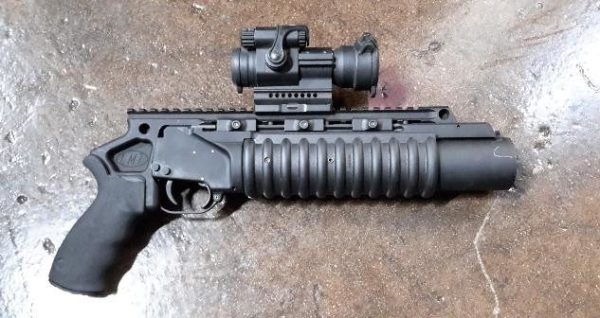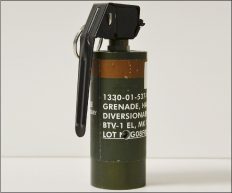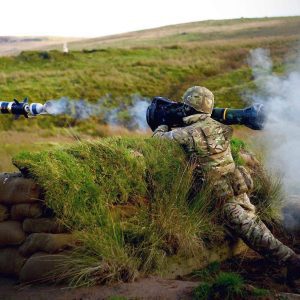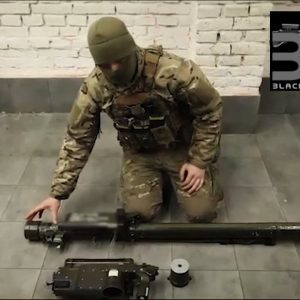M203 grenade launcher
$1,000.00
M203 handheld grenade 40mm launcher
The M203 grenade launcher is the primary grenade launcher of the US armed forces, and was the first weapon of this type to achieve operational service. It has been long-lived in operational service, and both used and produced in many nations.
The M203 may be fired from the shoulder in standing, kneeling, or prone positions. There is no backblast hazard, and a minimal muzzle blast hazard, allowing the weapon to be safely fired from any confined space. The weapon bearing the M203 may also be braced with its buttstock against the ground and the muzzle aimed upward, allowing the M203 to be used like a mortar. This is best accomplished from a sitting or prone position. It is also possible to fire the M203 from the hip, but accuracy will suffer accordingly. As it is mounted under the front of a larger weapon, the M203 cannot be fired one-handed like a pistol, as with the M79.
- Description
Description
M203 handheld grenade 40mm launcher
The M203 grenade launcher is the primary grenade launcher of the US armed forces, and was the first weapon of this type to achieve operational service. It has been long-lived in operational service, and both used and produced in many nations.
The background of the M203 is inter-tangled with those of many other projects and weapon systems. It was developed in response to the GLAD (Grenade Launcher Attachment Development) program, which was intended to provide the US Army with an underbarrel grenade launcher for use on the Colt XM16E1 assault rifle (which soon entered service as the M16); a much more difficult task than it sounds today, as at the time, no such weapon had ever been developed in the US. The GLAD program and the M16 were both offshoots of Project SALVO, which had originally been planned in 1951 to produce a multi-barrel assault rifle that fired flechette projectiles at tremendous rates of fire. GLAD was preceded by another SALVO offshoot, Project Niblick, which produced the 40×46 mm low-velocity grenade later needed for the GLAD weapon. Niblick also ultimately resulted in the development of the M79 grenade launcher that preceded the M203.
Project Niblick didn’t end with the M79, and it was from this program that the GLAD requirement arose from — though despite being considered a distinct program, it was tied directly to Project SALVO, as there were three competing rifle designs, and three competing grenade launchers. After being formalized in 1964, three competing weapons were submitted by the industry to the GLAD program; one by Colt, one by H&R, and one by AAI. The Colt CLG-4 was declared the winner and type-classified as the XM148 (not to be confused with the earlier Springfield Armory T148, which was a precursor to the M79), and Colt was contracted in July of 1966 to produce 20 000 of them for field trials in Southeast Asia. The first XM148s arrived in South Vietnam that December.
However, the US Army quickly regretted that decision. The Colt XM148 proved to be a disaster in actual combat conditions. It was prone to accidental discharges, was extremely laborious to field strip and clean, had numerous tiny parts that were easily lost in the field, and too heavy a trigger pull. This weapon was quickly pulled from service, and the Army soon reversed their decision in the GLAD program, awarding AAI a contract to build their grenade launcher after all. It was type-classified in November of 1968 as the XM203, and a month later the Army awarded AAI a contract to produce 600 of them for testing in Southeast Asia (apparently, the Army’s enthusiasm for exceptionally large initial orders was blunted by the failure of the XM148). Though later testing would reveal problems in arctic conditions, the XM203 performed well in Vietnam, and it was formally adopted into operational service with the US armed forces in 1969.
In appearance, the M203 more closely resembles *part* of a weapon than a complete weapon (which is not far from the truth, as it must be mounted on another weapon to use it). It consists of a long, partially-ribbed tube attached to a support rail above, and a trigger group aft. The aft ribbed portion of the barrel slides over the front of the barrel when the weapon is reloaded, and the chamber is located in this forward section. The upper rail not only supports the barrel, but is also used to attach the M203 to another weapon.
It is impossible to operate the M203 successfully unless it is attached to a larger weapon, usually an assault rifle. There are exceptions to this rule though; for example, variants of the MP5 submachine gun. In US military service, the M203 is attached to an M16 or M4. Attaching the M203 to a weapon is a procedure requiring only 5 minutes, and the only tool required is a screwdriver.
There are no sights on the M203; these must be fitted to the weapon that the launcher is attached to. Otherwise, the only reference with which to aim the launcher is the user’s best guess. The sights fitted to the main weapon consist of a front leaf and a rear ladder, with settings from 50 m to 250 m in 50 m increments.
To fire the M203, the operator must first unlock the barrel assembly via the barrel latch on the top-left side of the weapon, and slide the barrel assembly forward, and then backward, which cocks the weapon. The rear barrel assembly is then slid forward again, exposing the chamber; if an unfired round or a spent casing are in the chamber, it will be automatically extracted and ejected. A round may now be loaded into the chamber, and the slide drawn back. If completed properly, the extractor will catch the rim of the casing. The barrel is then locked into its fully-closed position by re-engaging the barrel latch, and the M203 may now be fired by simply pulling the trigger.
The M203 may be fired from the shoulder in standing, kneeling, or prone positions. There is no backblast hazard, and a minimal muzzle blast hazard, allowing the weapon to be safely fired from any confined space. The weapon bearing the M203 may also be braced with its buttstock against the ground and the muzzle aimed upward, allowing the M203 to be used like a mortar. This is best accomplished from a sitting or prone position. It is also possible to fire the M203 from the hip, but accuracy will suffer accordingly. As it is mounted under the front of a larger weapon, the M203 cannot be fired one-handed like a pistol, as with the M79.
A number of operational hazards in operating the M203 have also been identified, including reliability problems in severe cold conditions (though the M203’s cold weather problems have since been remedied), and the omission of a safety mechanism. A now famous quote from a US Army preventative maintenance magazine also states, “A slipping gear could let your M203 grenade launcher fire when you least expect it. That would make you quite unpopular in what’s left of your unit.”.
|





















